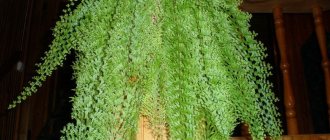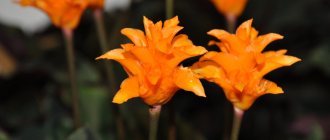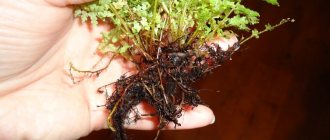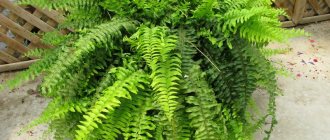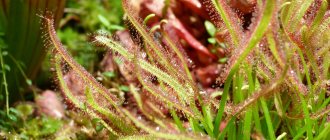Nephrolepis is a genus of fern plants that belong to the Lomariopsis family. The roots of the plant are not very developed, fibrous, superficial. Nephrolepis leaves are rich green in color, short and petiolate, abundant, creating dense rosettes. It grows up to 30 cm in height and up to 16 cm in width. The shape of nephrolepis is triangular-elongated, but with age it becomes belt-shaped. The leaf plates are arranged alternately, do not grow together, oval or deltoid, up to 8 cm long, most often with a small petiole. The leaf blades are even and smooth or with jagged edges. The petioles with stolons are strewn with small brownish hairs that hide their natural black color. There are about 40 plant species in total.
Nephrolepis cordifolia
This is an ornamental plant that grows well indoors. It is a deciduous perennial with shallow roots. On its roots, swellings often form in the form of nuts that do not have buds - these are tubers that store water and can be used for vegetative propagation. The leaves are arched, rich green in color, thick, often drooping, about 30-60 cm long and 5-6 cm wide. The leaves are versatile and formed on small petioles, up to 3 cm long and up to 1.5 cm wide, with jagged edges or whole, located close or far from each other. The popular variety Plumosaс is distinguished by its dark foliage color and gloss.
Home care
- Lighting for the successful development of Nephrolepis is either diffused natural or artificial, and the optimal temperature is +20 °C.
- Air humidity should be high, so the plant must be sprayed 1 to 3 times a day, depending on the ambient temperature, watered regularly, avoiding drying out of the soil and stagnation of water, and also ventilate the room, avoiding drafts.
- Simultaneously with watering, it is recommended to feed the fern twice a month, alternating organic fertilizers with mineral fertilizers for ornamental plants and ensuring that their quantity does not exceed a quarter of the dose indicated on the package.
- Young plants (up to 3 years old) are replanted annually, and adults - once every 3 years, by selecting a pot whose volume corresponds to the size of the root system, filling it with a light nutrient substrate and laying drainage at the bottom, and propagating ferns:
- shoots;
- dividing the bush;
- disputes;
- tubers.
Nephrolepis exaltata
Representatives of the sublime nephrolepis are similar to cordifolia - they are deciduous perennials with superficial roots. The leaves of the plant are unpaired and pinnate, light green in color, arched and often drooping, up to 70 cm long and up to 10 cm wide. The leaves are located on small red petioles, in a rosette, dense. With good care and maturity, the leaves of the plant can reach 1 meter in length. Individual leaves are large in size, up to 7 cm long and up to 1.2 cm wide. The rhizome of nephrolepis is upright, short, often not only with leaves, but also with stolons - leafless shoots, shoots that take root. The offspring are used for vegetative propagation. Varieties of species are numerous, differing in the characteristics of their leaves. This species is most often used in breeding work to develop new varieties. Thanks to him, we got many representatives with dissected leaves with double, triple and more pinnateness. There are varieties whose leaves are twice pinnate, and each of the leaves is pinnately dissected, etc.
Popular varieties of Nephrolepis sublime:
- "Bostoniensis". The leaves of this variety are pinnate, rich green, lanceolate, with a large rachis.
- "Hillsii". A special feature of the variety is the double pinnateness of the leaves.
- "Teddy Junior" The leaves of the variety are gorrated and wavy.
- "Superbissima". The leaves are characterized by triple pinnateness and are arranged very densely - overlapping each other.
- "Whitmanii". The leaves are lacy and have large cuts.
Reproduction
Ferns reproduce simply by dividing the bush and by suckers and shoots. Many garden varieties of nephrolepis are sterile or do not convey the varietal qualities of the mother plant. Therefore, it is propagated by dividing the mother plant during transplantation and by young plants formed at the ends of the “whiskers”.
Young plants are pinned to the soil and covered with soil for rooting. To speed up rooting, growing nephrolepis lashes must be periodically sprinkled with earth. When 3-4 leaves appear, they are planted in separate pots.
Nephrolepis bostoniensis
A species of nephrolepis that was cultivated from sublime in Boston (USA). A distinctive feature is the size of the leaves: they are arched with wavy edges, soft, up to 120 cm long. Boston nephrolepis is the progenitor of many species of this plant now known to us, for example, xiphoid. Most often grown for decorative purposes in interior spaces.
Popular varieties of Nephrolepis bostonensis:
- "Roosevelt". This is a popular representative of the species, its leaves are large in size with wavy edges.
- "Maassii". The variety is similar to "Roosevelt", but it is more compact, which simplifies care and gives the plant a sophisticated look.
- "Scottii" This is a low plant, its leaves are medium-sized with curled edges.
- "Fluffy Ruffles" The leaves are double pinnate, rigid with a large base.
- "Fluffy Duffy." A low plant, its leaves are double and triple pinnate, overlapping each other.
- "Whitmanh." Quite a tall plant, its leaves are triple pinnate.
- "Smithii". The leaves are small, four times pinnate.
- "Compacta". The plant is large in size.
- "Dallas Jewel" A low plant, it is highly resistant to any ailments.
- "Teddy Junior" The edges of the leaves are corrugated.
- "Linda" The edges of the leaves are ridge-shaped.
- "Tiger Eye" The leaves are variegated, rich green, sinewy.
Nephrolepis curly or curly
This group of plants was named so because their leaves are very similar to lace. The species was developed thanks to Nephrolepis sublime. There are only a few representatives of the species whose leaves are wavy or curled. The plant is short in stature and is particularly decorative due to its openwork leaves.
Popular varieties of nephrolepis curly:
- "Teddy Junior" The leaves are wavy.
- "Roosveltii". The leaves are wavy.
- "Maassii". The leaves are wavy.
- "Scottii" The leaves are curled.
Homeland and country of origin of the plant
Where does Nephrolepis come from? The tropical forests of Southeast Asia are considered the homeland of this fern species. The plant’s frequent habitat is also tropical areas in America, Africa and Australia. Outside the tropics it can be found in Japan and New Zealand.
In the wild, they lead an epiphytic and terrestrial lifestyle. Their leaves often exceed three meters in height.
Nephrolepis biserrata
This is a fairly large perennial plant. Its leaves are hard and shiny, semi-erect or arched, rich green in color with wavy edges, up to 2.5 meters long. Since the plant is tall, it needs a high room and special care; it is most often grown in public institutions, but not in residential premises. The plant is whimsical; with proper care and growing conditions, the perennial looks very decorative and attracts the eye.
Soil preparation
The soil for indoor ferns should be loose, allowing air and water to pass through. Stagnant moisture causes root rot. It is desirable that the soil contains a lot of rotted leaves and a little less pine needles and peat.
Ferns need soil with slightly increased acidity (pH is 5.0-6.6). The parameter is easily established using litmus paper. Soil (2 g) must be mixed with distilled water (10 ml). Shake the mixture and let it sit for a while. Then you need to lower litmus paper into the liquid above the sediment. At pH = 5 it will be yellow, and at 6 it will be greenish-yellow.
Nephrolepis Green Lady
The species was named “Green Lady” due to the elegance and aesthetics of the plant. Nephrolepis is highly decorative; its leaves are very delicate, light green in color, and droop. The leaves are curled at the tops, the leaf blades are wavy, which gives an openwork appearance to the contours. It is recommended to grow in good diffused light, but tolerates partial shade and artificial lighting. In this case, the light must be constant and not interrupted. Can be planted alone or together with another plant. This species is very similar to another variety of nephrolepis - Sonata, but its leaves are less drooping and the color of the leaves is lighter.
Transfer
Replant in spring in light soil. When planting, good drainage is provided at the bottom of the pot to prevent rotting of the soil and to ensure good air exchange for the roots. During transplantation, you should not cover the neck of the fern with soil - leave the top of the rhizome on the surface of the ground.
The soil.
For nephrolepis, the best is a mixture of equal parts of coniferous soil, greenhouse soil and peat with the addition of 5 g of bone meal per 1 kg of mixture. A mixture of 4 parts deciduous soil, 1 part peat and 1 part sand is also suitable. It is useful to add charcoal to the soil - it is a good bactericidal agent.
Nephrolepis exaltata sonata
This is an indoor plant that is often grown as an hanging crop in a hanging flowerpot or flowerpot. Light green leaves densely cover the plant. The plant is very useful because... its greens help purify the air and fight bacteria and harmful microelements. The plant is low-growing and very compact, feels good in ordinary pots, in lighted places and in partial shade.
There are other, less popular types of nephrolepis, for example, nephrolepis bisserata, acute, tuberose, oblierata, multiflora and pectinate.
Join our Facebook group
